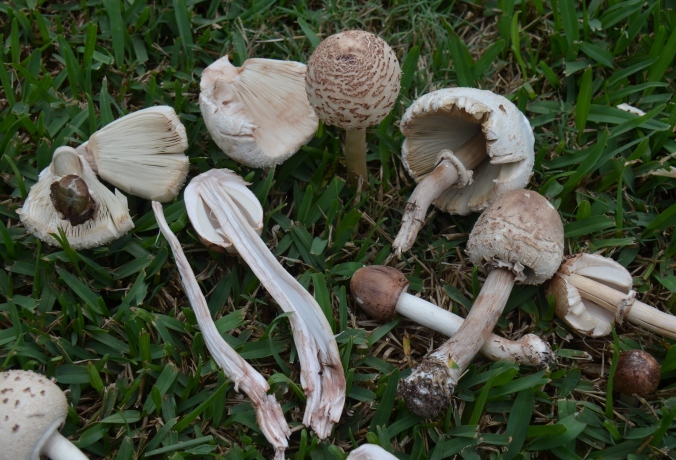
Some of the growth stages of Chlorophyllum molybdites aka the false parasol, green-spored parasol and the vomiter!
Chlorophyllum molybdites is one of the most common and widespread fungi in the world. This mushroom is most often seen kicked to pieces, scattered across urban lawns and stomped onto roads. One of the most despised of all fungi and probably the cause of more mushroom poisonings then any other. Is there any redeeming features to this common toadstool or is it deserving of its fate, to be mowed to ground level then poisoned by the suburban lawn enthusiast, relegated to a blight on the emerald dream of a perfectly trimmed and manicured patch of turf, just that little bit greener and neater then those bastards across the street.

mature Chlorophyllum molybdites
While a chew then spit, taste test is considered safe enough for most fungi, it is generally a bad idea to swallow. Chlorophyllum molybdites if eaten raw can lead to a heroes journey, a trip to hell and back riding the porcelain bus all the way to the emergency ward. It won’t kill you but leads to severe gastrointestinal distress, vomiting, diarrhea, and colic. The symptoms can last from a few hours to a few days! In severe cases, an affected person may experience bloody diarrhea and hypovolemic shock (Berger and Guss 2005). I am unable to find what the exact toxin in this fungi is but it is probably a protein. Whatever the toxin is, it is worth noting that the effects can vary greatly from person to person and in mushrooms that grow in different climates and regions. The toxin seems to be affected by heat, and some say boiling the mushroom for 30 minutes can destroy the poison and make the mushroom edible. Cooking the mushroom will probably lessen the effects of the poisoning but is unlikely to completely prevent it. The mushroom is also likely to be toxic to dogs.

Chlorophyllum molybdites and the classic green tinge on the gills.
This is not an easy mushroom to ID and is often mistaken for other edible fungi. It is not until the mushroom is fully mature that it gets the tell tale green gills, until that point the gills are white to cream sometimes with just a hint of grayish green. The mushroom looks and smells like it should be edible. The cap is convex, at first brown, as the mushroom expands the brown skin breaks into scales on a cream coloured second skin. At this stage it can be mistaken for the shaggy mane (Coprinus comatus). The cap expands into a classic mushroom shape before flattening out, covered with large or small brown scales. At this stage it is easily confused with other Chlorophyllum and macrolepiota species. If the mushroom dries in the sun the cap becomes brown again. The fibrous stem is often quite short but can be quite long with a bulbous base, it has a double ring which is movable on the stem. the flesh is white but can stain red. the spore print can be almost white to an ugly olive green. Chlorophyllum molybdites is found growing in parks and lawns, on roadsides and in fields. It is found around human habitation. It is prudent for anyone interested in edible fungi to become familiar with this species.
Advertisements Share this:




